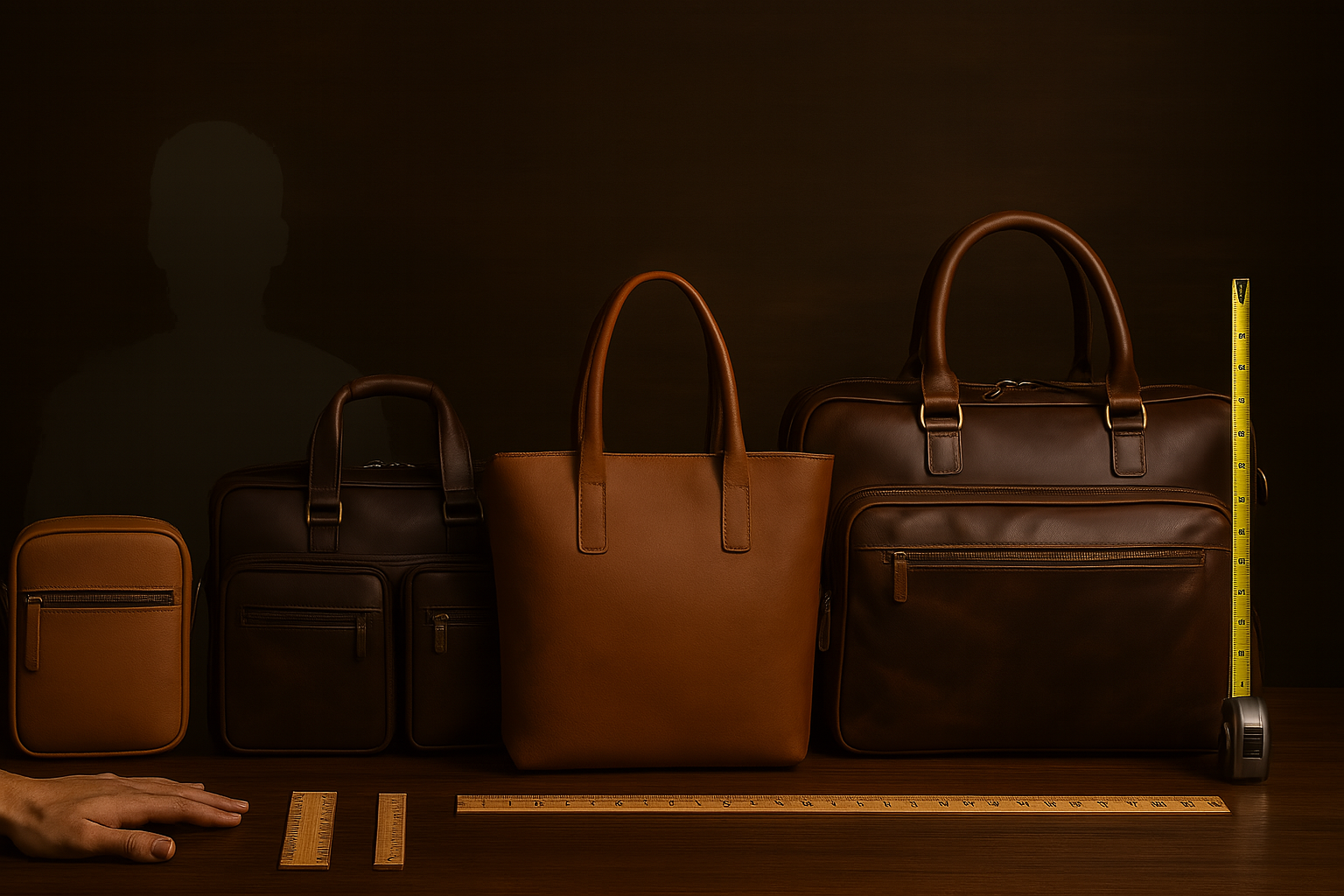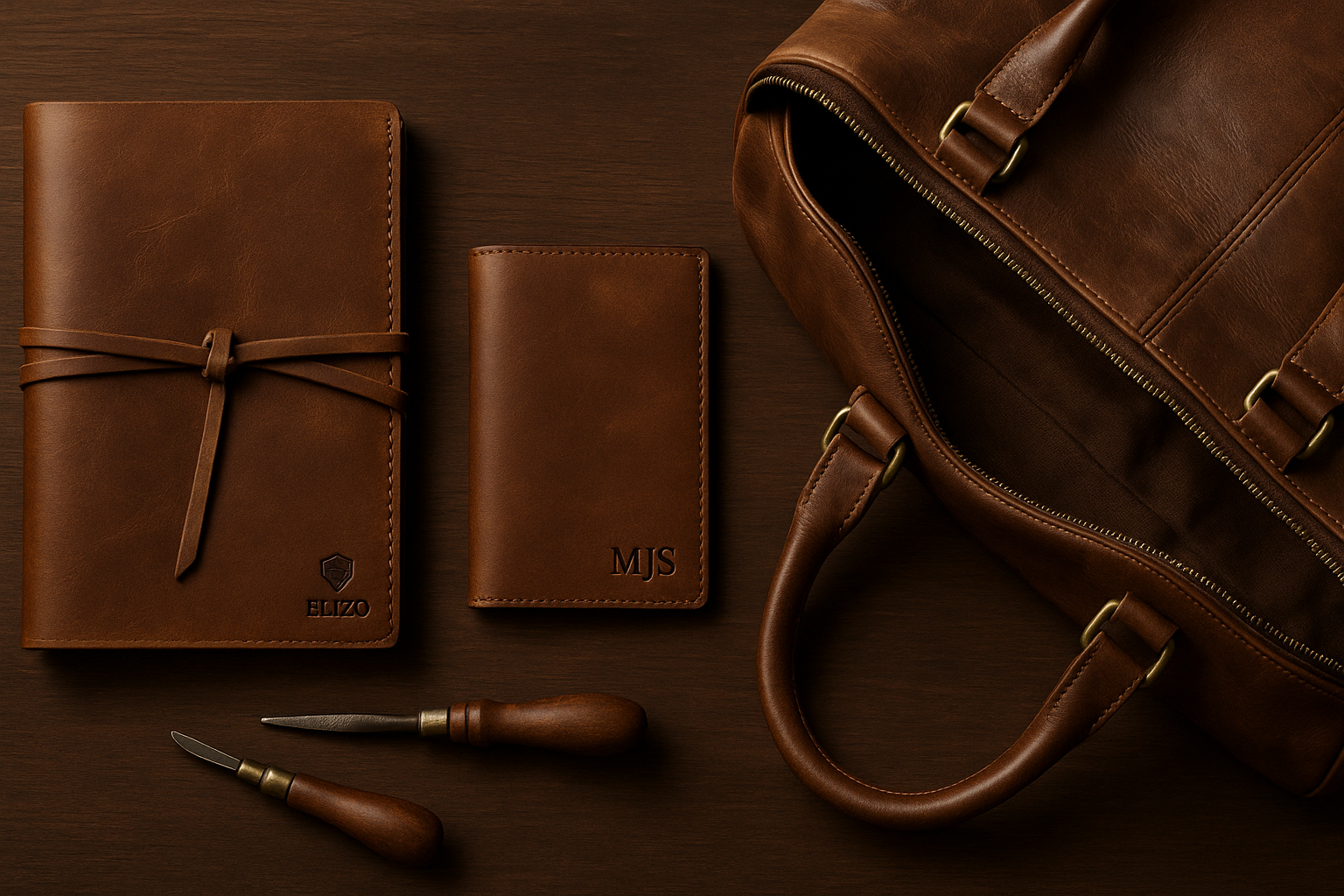
The Complete Leather Bag Sizing Guide: Finding Your Perfect Fit

Selecting the right size leather bag requires balancing carrying capacity with comfort, functionality with style, and personal preferences with practical limitations. The perfect leather bag should accommodate your essential items while maintaining comfortable portability and appropriate appearance across diverse usage contexts and lifestyle demands.
Bag sizing decisions impact daily comfort, organizational efficiency, and long-term satisfaction with your investment. Whether choosing a compact leather handbag for streamlined daily carry or a spacious leather duffle bag for extended travel, understanding sizing principles ensures your selection serves your actual needs rather than idealized preferences.
Understanding Bag Measurement Standards
Leather bag sizing involves multiple dimensions and capacity measurements that influence both functionality and appearance, requiring understanding of how different measurement approaches translate to real-world usage and carrying comfort.
Standard Dimension Measurements
Length, width, and height measurements provide basic size understanding while actual usable space depends on bag construction, internal organization, and structural elements that affect practical capacity beyond simple dimensional calculations.
External measurements differ from internal capacity due to leather thickness, structural reinforcement, and organizational features that consume space while providing durability and functionality benefits.
Expansion capabilities in some designs allow variable sizing that adapts to different carrying requirements while maintaining structural integrity and aesthetic appeal throughout diverse usage scenarios.
Volume and Capacity Considerations
Liter measurements provide standardized capacity comparison while actual functionality depends on item shape, organization features, and accessibility design that affects practical packing efficiency and daily usage patterns.
Weight distribution and balance influence carrying comfort regardless of total capacity, requiring consideration of how bag design distributes load across carrying surfaces and contact points.
Compartmentalization affects usable capacity by providing organization benefits while consuming space that might otherwise accommodate larger items or increased quantity of smaller belongings.
Lifestyle-Based Size Selection
Different lifestyles and usage patterns require adapted sizing approaches that balance capacity needs with portability requirements while ensuring bags remain comfortable and practical for intended activities.
Professional and Business Requirements
Business environments require bags that accommodate work materials while maintaining professional appearance and comfortable transport during commuting and client interactions throughout demanding work schedules.
Executive briefcases must balance laptop protection with document storage while remaining manageable for airport travel and urban navigation during business trips and daily professional activities.
Meeting and presentation requirements influence size selection based on material volume and technology needs while maintaining sophisticated appearance that supports professional credibility and business development.
Daily Carry and Personal Use
Everyday bags require balancing essential item storage with comfort and convenience while accommodating changing daily requirements and seasonal variation in carrying needs throughout diverse activities.
Urban navigation and public transportation compatibility affect optimal bag sizes while maintaining security and accessibility during crowded conditions and varied transportation modes throughout daily routines.
Personal organization preferences influence internal space requirements while external size constraints affect style coordination and carrying comfort throughout extended daily use and diverse activities.
Travel and Adventure Applications
Travel bags must accommodate clothing and essential items while meeting airline restrictions and maintaining comfortable transport through airports and diverse transportation modes during extended journeys.
Travel-specific sizing balances packing capacity with portability while ensuring bags remain manageable during navigation and handle airline baggage requirements throughout domestic and international travel.
Activity-specific requirements for adventure travel affect sizing based on equipment needs while maintaining comfortable transport during hiking, exploration, and outdoor activities throughout varied terrain and conditions.
Body Type and Ergonomic Considerations
Personal physical characteristics significantly influence optimal bag sizing while comfort and appearance depend on proportional relationships between bag dimensions and individual body measurements and carrying preferences.
Height and Proportion Matching
Bag size should complement rather than overwhelm personal proportions while maintaining comfortable carrying position and appropriate visual balance throughout extended use and diverse social contexts.
Strap length and adjustment range affect carrying comfort while ensuring bags maintain proper position and weight distribution across different body types and clothing variations throughout seasonal changes.
Scale relationships between bag size and personal height influence both comfort and appearance while ensuring accessories enhance rather than dominate overall presentation and style coordination.
Strength and Carrying Capacity
Individual physical capabilities influence maximum practical bag size while weight distribution design affects sustained carrying comfort during extended use and demanding travel conditions.
Age and fitness considerations affect optimal bag sizing while design features like wheels, multiple carrying options, and weight distribution systems can extend practical capacity beyond basic strength limitations.
Medical conditions and physical limitations require careful size selection while ergonomic design features can provide accessibility benefits that support independence and comfort throughout daily activities.
Activity-Specific Sizing Guidelines
Different activities require specialized sizing approaches that optimize functionality while maintaining appropriate appearance and comfort for specific usage contexts and performance requirements.
Business and Professional Contexts
Professional environments favor sized bags that accommodate work essentials while maintaining sophisticated appearance and comfortable transport during business activities and client interactions.
Laptop and technology requirements influence minimum size constraints while maximum dimensions depend on transportation modes and storage limitations in offices and meeting spaces throughout professional activities.
Document and material volume affects sizing needs while organization features can maximize efficiency within space constraints and support productive work habits throughout demanding schedules.
Casual and Social Activities
Social and recreational activities require bags that accommodate personal items while maintaining appropriate style and comfort for extended wearing during diverse entertainment and leisure pursuits.
Event and venue considerations influence optimal sizing while security and accessibility requirements affect internal organization and external design features throughout social and recreational activities.
Weather and seasonal factors affect carrying requirements while bag sizing must accommodate variable clothing and protection needs throughout changing environmental conditions and outdoor activities.
Travel and Transportation
Travel sizing requires balancing packing capacity with portability while meeting transportation restrictions and maintaining comfortable handling throughout varied journey types and destination requirements.
Airline carry-on restrictions influence maximum dimensions while practical portability affects optimal sizing for sustained carrying through airports and urban navigation during business and leisure travel.
International travel considerations affect sizing based on cultural appropriateness and practical requirements while ensuring bags remain manageable throughout diverse transportation modes and accommodation types.
Seasonal and Climate Adaptations
Seasonal changes affect carrying requirements while bag sizing must accommodate variable clothing, weather protection, and activity-specific equipment throughout changing environmental conditions and lifestyle demands.
Winter and Cold Weather Sizing
Cold weather clothing affects available space while bulky items require increased capacity planning and organizational strategies that maintain bag functionality throughout winter activities and professional obligations.
Indoor/outdoor transitions require bags that accommodate variable clothing while maintaining appropriate appearance for heated indoor environments and cold outdoor conditions throughout daily activities.
Seasonal activity equipment affects sizing requirements while bags must balance increased capacity needs with practical portability throughout winter sports and cold weather recreational activities.
Summer and Warm Weather Considerations
Lightweight summer clothing allows smaller bag sizing while increased outdoor activities might require additional capacity for sun protection, hydration, and recreational equipment throughout active seasons.
Vacation and leisure travel affect sizing requirements while bags must accommodate beach gear, casual clothing, and recreational equipment while maintaining comfortable transport throughout active travel periods.
Air conditioning and indoor cooling affect carrying comfort while bags must accommodate temperature regulation items and professional requirements throughout varied indoor and outdoor summer activities.
Organization and Internal Space Optimization
Internal organization features significantly affect usable capacity while thoughtful design can maximize functionality within size constraints and improve accessibility throughout daily use and varied activities.
Compartmentalization Benefits and Trade-offs
Multiple compartments provide organization benefits while consuming space that could otherwise accommodate larger items or increased volume of smaller belongings throughout diverse usage scenarios.
Flexible organization systems allow adaptation to changing requirements while maintaining structural benefits and accessibility features that support efficient daily use and varied carrying needs.
Security and protection features affect usable space while providing benefits for valuable items and important documents throughout travel and daily activities in diverse security environments.
Accessibility and Functionality Design
Opening mechanisms and access points influence practical usability while bag sizing must accommodate both storage and retrieval requirements throughout varied usage contexts and time constraints.
External pocket placement affects functionality while internal organization design influences space efficiency and accessibility throughout rapid access needs and organized storage requirements.
Technology integration requires dedicated space allocation while modern device requirements affect sizing considerations and organizational features throughout contemporary professional and personal activities.
Material Considerations and Size Impact
Leather characteristics affect both available space and carrying weight while construction methods influence durability and capacity throughout extended use and demanding conditions.
Leather Thickness and Structure
Leather gauge affects both durability and available internal space while construction methods influence weight and structural integrity throughout intensive use and varied carrying conditions.
Reinforcement and structural elements consume space while providing durability benefits that support long-term use and maintain bag shape throughout demanding conditions and heavy loading.
Flexibility and break-in characteristics affect initial sizing while leather adaptation over time can influence capacity and shape throughout extended ownership and regular use patterns.
Hardware and Construction Weight
Metal hardware adds weight while providing durability and functionality benefits that support long-term use and maintain operational reliability throughout intensive daily use and travel conditions.
Construction methods affect both weight and capacity while quality assembly techniques ensure structural integrity and maintain bag shape throughout extended use and demanding conditions.
Reinforcement placement influences weight distribution while structural elements provide durability benefits that support heavy loading and intensive use throughout professional and travel applications.
Sizing for Different Bag Types
Different leather bag styles require adapted sizing approaches that consider their specific functional requirements and aesthetic proportions while ensuring optimal performance for intended applications.
Handbags and Personal Carry
Leather tote bags require sizing that balances capacity with proportional appearance while maintaining comfortable carrying and appropriate scale for personal dimensions and style preferences.
Structured handbags maintain consistent proportions while size selection affects both functionality and visual impact throughout professional and social contexts where appearance and practicality intersect.
Crossbody and messenger styles require size-to-comfort optimization while ensuring bags remain proportional and functional throughout extended wearing and varied activity levels.
Professional and Business Bags
Briefcases require sizing based on technology and document requirements while maintaining professional proportions and comfortable transport throughout business travel and daily professional use.
Messenger bags balance capacity with portability while ensuring professional appearance and ergonomic comfort throughout urban commuting and business activities.
Portfolio and document cases require sizing based on material volume while maintaining slim profiles that support professional presentation and convenient transport throughout business interactions.
Travel and Luggage Applications
Duffle bags require sizing based on trip duration and transportation constraints while maintaining comfortable portability and meeting airline restrictions throughout domestic and international travel.
Toiletry bags need sizing that accommodates personal care items while maintaining compact portability and organized accessibility throughout travel and daily use requirements.
Weekend and overnight bags balance packing capacity with carry-on compatibility while ensuring comfortable transport throughout short-term travel and recreational activities.
Technology and Modern Requirements
Contemporary sizing requirements include technology accommodation while maintaining traditional aesthetics and ensuring bags serve modern professional and personal needs throughout evolving digital lifestyles.
Device Protection and Organization
Laptop and tablet sizing requirements affect minimum bag dimensions while protection features influence internal organization and space allocation throughout technology-dependent professional and personal activities.
Charging and cable organization requires dedicated space allocation while maintaining overall capacity and ensuring accessibility throughout extended use and travel requirements.
Multiple device accommodation affects sizing requirements while ensuring protection and organization features support modern multi-device lifestyles and professional technology demands.
Connectivity and Modern Features
Technology integration features require space allocation while maintaining traditional leather aesthetics and ensuring modern functionality supports contemporary professional and personal requirements.
Security and protection systems might affect sizing while providing benefits for valuable technology and important information throughout travel and daily use in diverse security environments.
Future-proofing considerations influence sizing decisions while ensuring bags accommodate evolving technology requirements throughout extended ownership periods and changing professional needs.
Budget and Investment Considerations
Sizing decisions affect cost while investment value depends on matching capacity to actual needs and ensuring long-term satisfaction throughout extended ownership and changing lifestyle requirements.
Cost-Per-Capacity Analysis
Larger bags typically offer better capacity value while optimal sizing depends on actual usage patterns and ensuring investment matches practical requirements rather than aspirational capacity desires.
Quality construction costs vary with size while investment value depends on durability and functionality benefits that support long-term use and satisfaction throughout demanding conditions and intensive use.
Versatility benefits from optimal sizing while ensuring bags serve multiple purposes and contexts throughout changing professional and personal requirements and lifestyle evolution.
Long-Term Value and Adaptability
Sizing decisions affect long-term satisfaction while bags should accommodate changing needs and provide continued utility throughout evolving lifestyle and professional requirements.
Resale and gift value depend on sizing appropriateness while bags should maintain broad appeal and utility beyond original owner requirements and preferences.
Investment protection through optimal sizing ensures bags provide continued value while supporting changing needs and maintaining relevance throughout extended ownership periods.
Conclusion: Finding Your Perfect Size Match
Successful leather bag sizing requires honest assessment of actual needs versus idealized preferences while ensuring selections provide optimal balance between capacity, comfort, and aesthetic appeal throughout intended usage scenarios.
The perfect bag size enhances rather than complicates daily activities while providing adequate capacity without unnecessary bulk that affects comfort and portability throughout extended use and varied activities.
Whether selecting a compact wallet-style carrier for minimal needs or a comprehensive leather bag for extensive requirements, thoughtful sizing ensures investment satisfaction and practical utility throughout changing lifestyle demands.
Remember that optimal sizing supports your actual lifestyle rather than aspirational ideals while ensuring bags provide comfortable utility and appropriate appearance throughout diverse professional and personal contexts.
Choose leather bag sizes that reflect realistic carrying patterns while considering comfort, practicality, and aesthetic preferences that ensure long-term satisfaction with your investment in quality leather accessories.
For personalized sizing guidance and to explore our complete range of leather bags in various sizes, consider your specific needs and lifestyle requirements while evaluating how different sizes will serve your unique combination of professional and personal activities throughout extended ownership periods.




